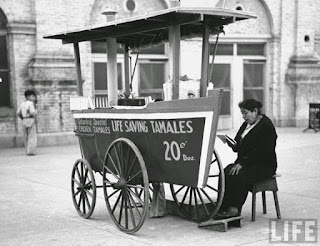Life Saving Tamales - 1939 Brownsville Market Square Plaza by Carl Mydans LIFE magazine. Colorized by Bronsbi Estacion.
She came to the U.S. as an illegal immigrant
While in Brownsville
she found love, hardship and the American Dream
By Rene Torres
Felicitas Ramirez was not any different than the many of
today who want to come to this country for a better life. As a youngster she grew tired of the many
stories she heard of the wonderful opportunities afforded in the United States.
So in 1912, Falicitas decided to take the journey from
Huatuzco, Veracruz to the promised land.
Carrying only the necessities and risking her life—she safely crossed
the river and made Brownsville her home—and before long found employment as a
housemaid with a pioneer family in town.
After several years in Brownsville, she found love when she
meets Miguel Izquierdo, a legal citizen of the United States born in
Brownsville. Miguel sold home-made
candy, moving his portable display counter from street to street or wherever
there was a demand for his candy.
Miguel expressed to Felicitas that he needed help with his
business, so in 1919 they married. She
continued to make home-made candy until 1924, when a more lucrative trade
attracted him.
There was more money
in Tamales
In 1937, Bill Brewster of the Herald wrote their story, “He built a small, two-wheel cart and
began selling tamales. Each day while
his wife worked at home cooking, Miguel wheeled his wagon to a location by the
memorial fountain of the Market Square and hawked his wares. The tamales were excellent and Miguel’s
tamales prospered. He soon became known
to his customers as the “Tamale King.”
Business was thriving and the original wagon was
inadequate. Miguel saw the need to build
a second one that resembled a small steamboat.
It was mounted on wheels and from its smokestack raised steam from the
heated tamales. From then on the her
tamales were known as the “Life Saving
Tamales.”
Only seven years after their marriage, one day Miguel failed
to show at Market Square. The entrepreneur
who had work so hard to build his business was dead. Customers wondered if the “Life Saving Tamales”
were a thing of the past.
But then after Felicitas replaced the “King,” to continue the
sale of tamales from the familiar little steamboat cart located at its usual place.
Because her responsibilities grew of now making and selling,
she was forced to change her hours. No
longer was the wagon standing at the Market Square all day. Her business hours were from 4:00 p.m. to
7:30 p.m.
It was common for many of her customers to go by her house
on Twelfth Street opposite the courthouse where they could also buy the fresh
beef, pork or chicken tamales.
The once illegal immigrant that came to this county to live
the American dream—with weary hands and fingers was still selling tamales in
1937. Although she knew no English,
Felicitas had found it necessary to learn enough to handle her trade, for the
majority of her customers were English speaking who knew no Spanish.
Miguel set the foundation for a successful business, but
Felicitas convinced the people, her customers, she had something they wanted. The amazing thing is that part of their story
occurred during the “Great Depression.”
Was Grover Cleveland thinking about Felicitas when he wrote
“a truly American sentiment recognizes the dignity of labor and the fact that
honor lies in honest toil?”
Public Market and Town Hall Photograph no12 The Portal to Texas History.
Mydans' photo in original black & white




No comments:
Post a Comment